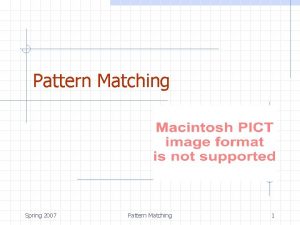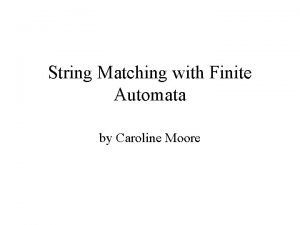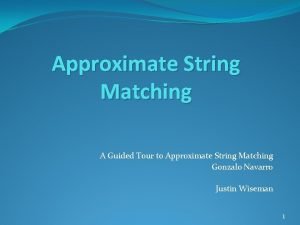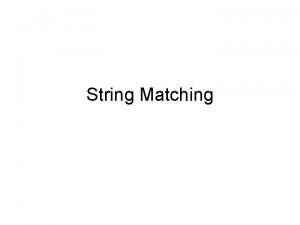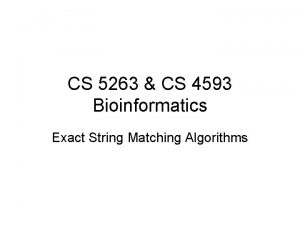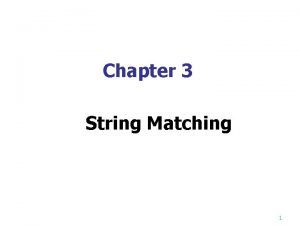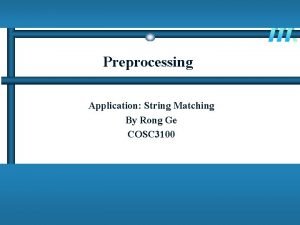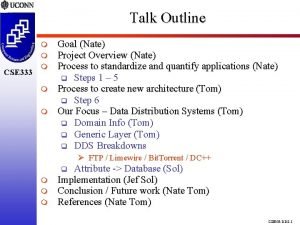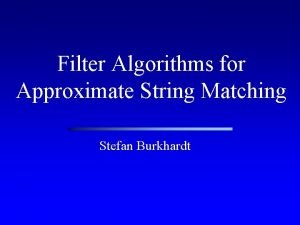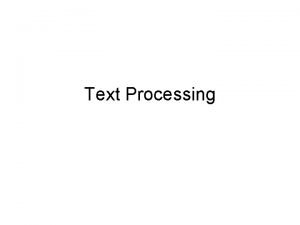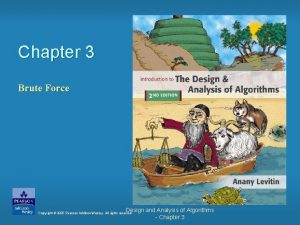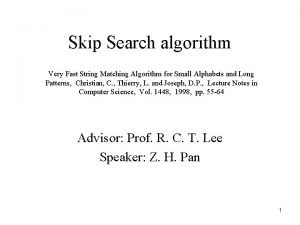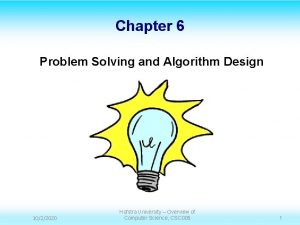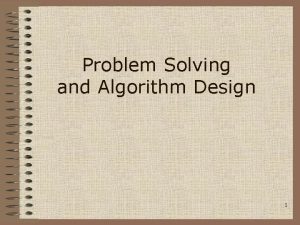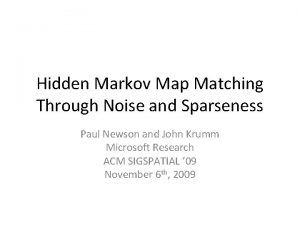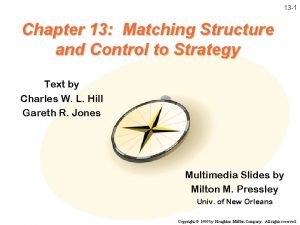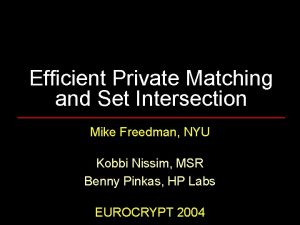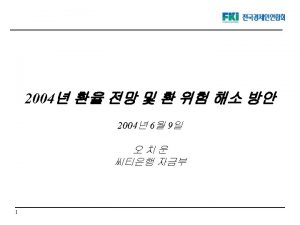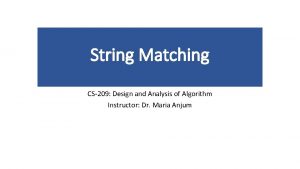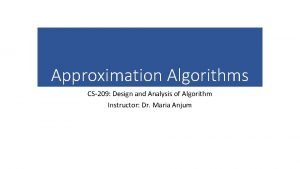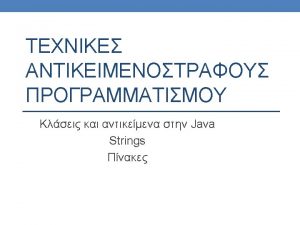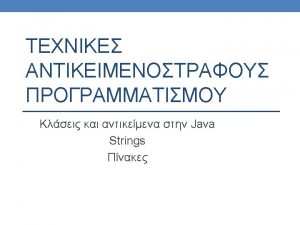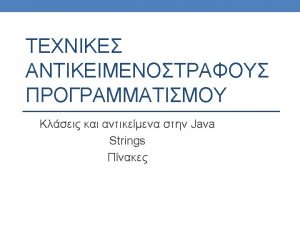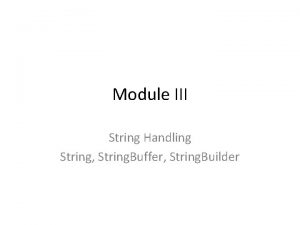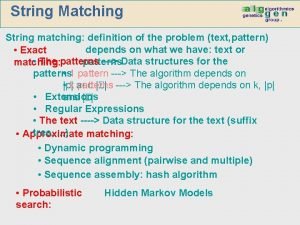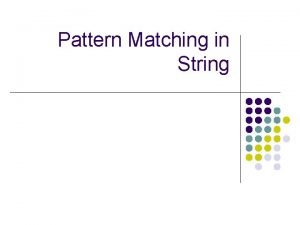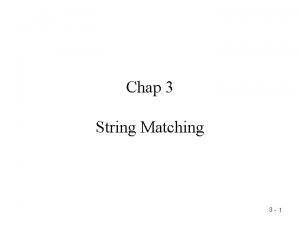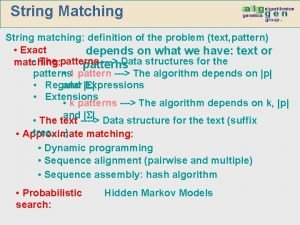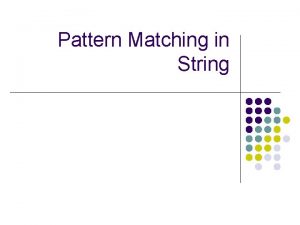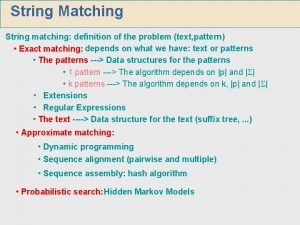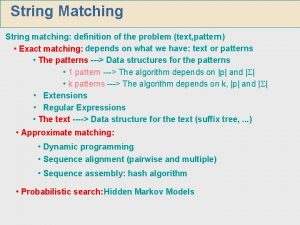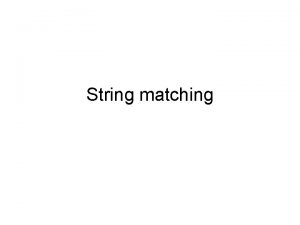String Matching CS209 Design and Analysis of Algorithm










































- Slides: 42

String Matching CS-209: Design and Analysis of Algorithm Instructor: Dr. Maria Anjum

Contents • Naïve Algorithm • Knuth Morris Pratt (KMP) Algorithm • Robin Karp algorithm • Finite Automata

String Matching Algorithms • String matching algorithms tries to find one or more indices where one or several strings (pattern) are found in the larger string (text). • • • Use of String matching algorithms Can greatly aid the responsiveness of the text-editing program. String-matching algorithms search for particular patterns in DNA sequences. Internet search engines also use them to find Web pages relevant to queries. Plagiarism checking in documents Bioinformatics

String Matching Algorithms - Formal Definition of String Matching Problem - Assume text is an array T[1. . n] of length n and the pattern is an array P[1. . m] of length m ≤ n This means: • there is a string array T which contains a certain number of characters that is larger than the number of characters in string array P. • P is said to be the pattern array because it contains a pattern of characters to be searched for in the larger array T.

Naïve Algorithm • • Naïve Algorithm also known as brute-force algorithm It is the simplest method among other pattern searching algorithms. It checks all character of the main string (T) to the pattern (P). This algorithm is useful for smaller texts. It does not need any pre-processing phases. Algorithm is space efficient and does not take extra space. The time complexity of Naïve Pattern Search method is O(m*n). The m is the size of pattern and n is the size of the main string.

Naïve Algorithm Example Cont. index i 1 2 3 4 5 6 7 8 9 10 11 12 a b c d f string Pattern: a b c d f j • Move j and i until there is a mismatch. • In case of mismatch • shift j to the starting point • i will start from index 2

Naïve Algorithm Example Cont. index i 1 2 3 4 5 6 7 8 9 10 11 12 a b c d f • Move j and i until there is a mismatch. • In case of mismatch • shift j to the starting point • i will start from index 2 Pattern: a b c d f Index i = 1 value = a j 1 Index j =1 Pattern value = a No mismatch therefore move i and j i-e i++ and j++

Naïve Algorithm Example Cont. index i 1 2 3 4 5 6 7 8 9 10 11 12 a b c d f • Move j and i until there is a mismatch. • In case of mismatch • shift j to the starting point • i will start from index 2 Pattern: a b c d f j Index i = 2 value =b 2 Index j = 2 Pattern value =b No mismatch therefore move i and j i-e i++ and j++

Naïve Algorithm Example Cont. index i 1 2 3 4 5 6 7 8 9 10 11 12 a b c d f • Move j and i until there is a mismatch. • In case of mismatch • shift j to the starting point • i will start from index 2 Pattern: a b c d f Index i =3 value = c j 3 Index j = 3 Pattern value = c No mismatch therefore move i and j i-e i++ and j++

Naïve Algorithm Example Cont. index i 1 2 3 4 5 6 7 8 9 10 11 12 a b c d f • Move j and i until there is a mismatch. • In case of mismatch • shift j to the starting point • i will start from index 2 Pattern: a b c d f j Index I = 4 value = d 4 Index j = 4 Pattern value = d No mismatch therefore move i and j i-e i++ and j++

Naïve Algorithm Example Cont. index i 1 2 3 4 5 6 7 8 9 10 11 12 a b c d f • Move j and i until there is a mismatch. • In case of mismatch • shift j to the starting point • i will start from index 2 Pattern: a b c d f Index i = 5 value = a j 5 Index j = 5 Pattern value = f mismatch therefore Move j to index 1 move i to index 2 In other words reset index I and j

Naïve Algorithm Example Cont. index i 1 2 3 4 5 6 7 8 9 10 11 12 a b c d f • Move j and i until there is a mismatch. • In case of mismatch • shift j to the starting point • i will start from index 2 Pattern: a b c d f Index i= 2 value =b j 6 Index j = 1 Pattern value =a mismatch therefore move i to next index Move j to index 1 Guess what will be the index for i? In other words reset index I and j

Naïve Algorithm Example Cont. index i 1 2 3 4 5 6 7 8 9 10 11 12 a b c d f • Move j and i until there is a mismatch. • In case of mismatch • shift j to the starting point • i will start from index 2 Pattern: a b c d f Index i = 3 value = c j 7 Please complete the rest of the iterations Index j = 1 Pattern value =a mismatch therefore move i to next index Move j to index 1 Guess what will be the index for i? In other words reset index I and j

Naïve Algorithm Example 1 2 3 4 5 6 7 8 9 10 11 12 a b c d f Pattern: a b c d f j • Move j and i until there is a mismatch. • In case of mismatch • shift j to the starting point • i will start from index 2

Naïve Algorithm • The naive string-matcher is inefficient because it entirely ignores information gained about the text for one value of T when it considers other values of s.

• What will be the time complexity of Naïve Algorithm? • What will be the pseudo code for this?

Knuth Morris Pratt (KMP) Algorithm • This algorithm was conceived by Donald Knuth and Vaughan Pratt and independently by James H. Morris in 1977. • Knuth, Morris and Pratt discovered first linear time string-matching algorithm by analysis of the naïve algorithm. • It keeps the information that naive approach wasted information gathered during the scan of the text. • By avoiding this waste of information, it achieves a running time of O(n). • The implementation of Knuth-Morris-Pratt algorithm is efficient because it minimizes the total number of comparisons of the pattern against the input string.

Knuth Morris Pratt (KMP) Algorithm • • Compares from left to right. Shifts more than one position. Preprocessing approach of Pattern to avoid trivial comparisons. Avoids recomputing matches.

Knuth Morris Pratt (KMP) Algorithm i Array T 1 2 3 4 5 6 7 8 9 10 11 12 13 14 15 a b c a b a b d Pattern: a b d J=0 Index [j] 0 1 2 3 4 5 P[i] a b d Pi [j] 0 0 1 2 0 Zero index not assigned to anyone before and a or b did not appear on any previous index. 1. 2. 3. 4. 5. 6. • • Compare i with j+1 If match then Move i Move j Repeat 1 -4 steps until mismatch Move j to index below alphabet Go to step 1 Repeat until mismatch Move j to index below alphabet If j reached zero and cant go back, move i

Knuth Morris Pratt (KMP) Algorithm i Array T 1 2 3 4 5 6 7 8 9 10 11 12 13 14 15 a b c a b a b d Pattern: a b d J=0 J+1 Index [j] 0 1 2 3 4 5 P[i] a b d Pi [j] 0 0 1 2 0 i=1 Initial state J=0 1 - Compare i with j+1 i=0, value = a j+1=1 , value = a 2 - If match 3 - Move j; (j will move to index 1 as it was on index 0 and we compared j+1) 4 - Move i; (i will move to index 2) Please note: After this step j=1 and i=2

Knuth Morris Pratt (KMP) Algorithm i Array T 1 2 3 4 5 6 7 8 9 10 11 12 13 14 15 a b c a b a b d Iteration Pattern: a b d J J+1 Index [j] 0 1 2 3 4 5 P[i] a b d Pi [j] 0 0 1 2 0 2 i=2 j=1 1 - Compare i with j+1 i=2, value = b j+1=2 , value = b 2 - If match 3 - Move j; (j will move to index 2 as it was on index 1 and we compared j+1) 4 - Move i; (i will move to index 3) Please note: After this step j=2 and i=3

Knuth Morris Pratt (KMP) Algorithm i Array T 1 2 3 4 5 6 7 8 9 10 11 12 13 14 15 a b c a b a b d Iteration Pattern: a b d J J+1 Index [j] 0 1 2 3 4 5 P[i] a b d Pi [j] 0 0 1 2 0 3 i=3 j=2 1 - Compare i with j+1 i=3, value = a j+1=3 , value = a 2 - If match 3 - Move j; (j will move to index 3 as it was on index 2 and we compared j+1) 4 - Move i; (i will move to index 4) Please note: After this step j=3 and i=4

Knuth Morris Pratt (KMP) Algorithm i Array T 1 2 3 4 5 6 7 8 9 10 11 12 13 14 15 a b c a b a b d Iteration Pattern: a b d J J+1 Index [j] 0 1 2 3 4 5 P[i] a b d Pi [j] 0 0 1 2 0 4 i=4 j=3 1 - Compare i with j+1 i=4, value = b j+1=4 , value = b 2 - If match 3 - Move j; (j will move to index 4 as it was on index 3 and we compared j+1) 4 - Move i; (i will move to index 5) Please note: After this step j=4 and i=5

Knuth Morris Pratt (KMP) Algorithm i Array T 1 2 3 4 5 6 7 8 9 10 11 12 13 14 15 a b c a b a b d Iteration Pattern: a b d J J+1 Index [j] 0 1 2 3 4 P[i] a b Pi [j] 0 0 1 2 J will move to index 2 5 i=5 j=4 1 - Compare i with j+1 i=5, value = c j+1=5 , value = d 5 2 - If match 3 - Move j; (j will move to index 4 as it was on d index 3 and we compared j+1) 0 4 - Move i; (i will move to index 5) 5 - Mismatch 6 - Move j to index below alphabet (here check index below letter b its index 2 7 - go to step 1 and compare Please note: After this step j=2 and i=5, we did not increment i

Knuth Morris Pratt (KMP) Algorithm i Array T 1 2 3 4 5 6 7 8 9 10 11 12 13 14 15 a b c a b a b d Iteration Pattern: a b d J J+1 Index [j] 0 1 2 3 4 5 P[i] a b d Pi [j] 0 0 1 2 0 J will move to index 0 6 i=5 j=2 1 - Compare i with j+1 i=5, value = c j+1=3 , value = a 2 - If match 3 - Move j; (j will move to index 4 as it was on index 3 and we compared j+1) 4 - Move i; (i will move to index 5) 5 - Mismatch (again) 6 - Move j to index below alphabet (here index below letter b is 0) 7 - go to step 1 and compare Please note: After this step j=0 and i=5

Knuth Morris Pratt (KMP) Algorithm i Array T 1 2 3 4 5 6 7 8 9 10 11 12 13 14 15 a b c a b a b d Iteration 7 i=5, j=0 1 - Compare i with j+1 i=5, value = c j+1=1 , value = a Pattern: a b d J J+1 Index [j] 0 1 2 3 4 5 P[i] a b d Pi [j] 0 0 1 2 0 Please note: After this step j=0 and i=6, we incremented i 2 - If match 3 - Move j; (j will move to index 4 as it was on index 3 and we compared j+1) 4 - Move i; (i will move to index 5) 5 - Mismatch (again) 6 - Move j to index below alphabet (here index below letter a its index 0 and j is already on 0 index. We can go beyond) 7 - go to step 1 and compare 8 -Increment i 9 - go to step 1 and compare

Knuth Morris Pratt (KMP) Algorithm i Array T 1 2 3 4 5 6 7 8 9 10 11 12 13 14 15 a b c a b a b d Iteration Pattern: a b d J J+1 Index [j] 0 1 2 3 4 5 P[i] a b d Pi [j] 0 0 1 2 0 Please note: After this step j=1 and i=7 8 i=6, j=0 1 - Compare i with j+1 i=6, value = a j+1=1 , value = a 2 - If match 3 - Move j; (j will move to index 1 as it was on index 0 and we compared j+1) 4 - Move i; (i will move to index 7) 5 - Mismatch (again) 6 - Move j to index below alphabet (here index below letter a its index 0 and j is already on 0 index. We can go beyond) 7 - go to step 1 and compare 8 -Increment i 9 - go to step 1 and compare

Knuth Morris Pratt (KMP) Algorithm i Array T 1 2 3 4 5 6 7 8 9 10 11 12 13 14 15 a b c a b a b d Iteration Pattern: a b d J J+1 Index [j] 0 1 2 3 4 5 P[i] a b d Pi [j] 0 0 1 2 0 Please note: After this step j=2 and i=8 9 i=7, j=1 1 - Compare i with j+1 i=7, value = b j+1=1 , value = b 2 - If match 3 - Move j; (j will move to index 2 as it was on index 1 and we compared j+1) 4 - Move i; (i will move to index 8) 5 - Mismatch (again) 6 - Move j to index below alphabet (here index below letter a its index 0 and j is already on 0 index. We can go beyond) 7 - go to step 1 and compare 8 -Increment i 9 - go to step 1 and compare

Knuth Morris Pratt (KMP) Algorithm i Array T 1 2 3 4 5 6 7 8 9 10 11 12 13 14 15 a b c a b a b d Iteration 10 i=8, j=2 1 - Compare i with j+1 i=8, value = c j+1=3 , value = a Pattern: a b d J J+1 Index [j] 0 1 2 3 4 5 P[i] a b d Pi [j] 0 0 1 2 0 J will move to index 0 Please note: After this step j=0 and i=8 2 - If match 3 - Move j; (j will move to index 2 as it was on index 1 and we compared j+1) 4 - Move i; (i will move to index 8) 5 - Mismatch (again) 6 - Move j to index below alphabet (here index below letter b its index 0, so j moved to index 0) 7 - go to step 1 and compare 8 -Increment i 9 - go to step 1 and compare

Knuth Morris Pratt (KMP) Algorithm i Array T 1 2 3 4 5 6 7 8 9 10 11 12 13 14 15 a b c a b a b d Iteration 11 i=8, j=0 1 - Compare i with j+1 i=8, value = c j+1=1 , value = a Pattern: a b d J J+1 Index [j] 0 1 2 3 4 5 P[i] a b d Pi [j] 0 0 1 2 0 J is already index 0 Please note: After this step j=0 and i=9, i will be incremented 2 - If match 3 - Move j; (j will move to index 2 as it was on index 1 and we compared j+1) 4 - Move i; (i will move to index 8) 5 - Mismatch 6 - Move j to index below alphabet (here index below letter a is 0, and j is already at index 0) 7 - go to step 1 and compare 8 -Increment i 9 - go to step 1 and compare

Knuth Morris Pratt (KMP) Algorithm i Array T 1 2 3 4 5 6 7 8 9 10 11 12 13 14 15 a b c a b a b d Iteration Pattern: a b d J J+1 Index [j] 0 1 2 3 4 5 P[i] a b d Pi [j] 0 0 1 2 0 Please note: After this step j=1 and i=10 12 i=9, j=0 1 - Compare i with j+1 i=9, value = a j+1=1 , value = a 2 - If match 3 - Move j; (j will move to index 1 as it was on index 0 and we compared j+1) 4 - Move i; (i will move to index 10) 5 - Mismatch 6 - Move j to index below alphabet (here index below letter a is 0, and j is already at index 0) 7 - go to step 1 and compare 8 -Increment i 9 - go to step 1 and compare

Knuth Morris Pratt (KMP) Algorithm i Array T 1 2 3 4 5 6 7 8 9 10 11 12 13 14 15 a b c a b a b d Iteration Pattern: a b d J J+1 Index [j] 0 1 2 3 4 5 P[i] a b d Pi [j] 0 0 1 2 0 Please note: After this step j=2 and i=11 13 i=10, j=1 1 - Compare i with j+1 i=10, value = b j+1=2 , value = b 2 - If match 3 - Move j; (j will move to index 2) 4 - Move i; 5 - Mismatch 6 - Move j to index below alphabet (here index below letter a is 0, and j is already at index 0) 7 - go to step 1 and compare 8 -Increment i 9 - go to step 1 and compare

Knuth Morris Pratt (KMP) Algorithm i Array T 1 2 3 4 5 6 7 8 9 10 11 12 13 14 15 a b c a b a b d Iteration Pattern: a b d J J+1 Index [j] 0 1 2 3 4 5 P[i] a b d Pi [j] 0 0 1 2 0 Please note: After this step j=3 and i=12 14 i=11, j=2 1 - Compare i with j+1 i=11, value = a j+1=3 , value = a 2 - If match 3 - Move j; (j will move to index 3) 4 - Move i; 5 - Mismatch 6 - Move j to index below alphabet (here index below letter a is 0, and j is already at index 0) 7 - go to step 1 and compare 8 -Increment i 9 - go to step 1 and compare

Knuth Morris Pratt (KMP) Algorithm i Array T 1 2 3 4 5 6 7 8 9 10 11 12 13 14 15 a b c a b a b d Iteration Pattern: a b d J J+1 Index [j] 0 1 2 3 4 5 P[i] a b d Pi [j] 0 0 1 2 0 Please note: After this step j=4 and i=13 15 i=12, j=3 1 - Compare i with j+1 i=12, value = b j+1=4 , value = b 2 - If match 3 - Move j; (j will move to index 4) 4 - Move i; 5 - Mismatch 6 - Move j to index below alphabet (here index below letter a is 0, and j is already at index 0) 7 - go to step 1 and compare 8 -Increment i 9 - go to step 1 and compare

Knuth Morris Pratt (KMP) Algorithm i Array T 1 2 3 4 5 6 7 8 9 10 11 12 13 14 15 a b c a b a b d Iteration Pattern: a b d J J+1 Index [j] 0 1 2 3 4 5 P[i] a b d Pi [j] 0 0 1 2 0 Please note: After this step j=2 and i=13 15 i=13, j=4 1 - Compare i with j+1 i=13, value = a j+1=5 , value = d 2 - If match 3 - Move j; (j will move to index 4) 4 - Move i; 5 - Mismatch 6 - Move j to index below alphabet (here index below letter b is 2, and j moved to index 2) 7 - go to step 1 and compare 8 -Increment i 9 - go to step 1 and compare

Knuth Morris Pratt (KMP) Algorithm i Array T 1 2 3 4 5 6 7 8 9 10 11 12 13 14 15 a b c a b a b d Iteration Pattern: a b d J J+1 Index [j] 0 1 2 3 4 5 P[i] a b d Pi [j] 0 0 1 2 0 Please note: After this step j=3 and i=14 16 i=13, j=2 1 - Compare i with j+1 i=13, value = a j+1=3 , value = a 2 - If match 3 - Move j; (j will move to index 4) 4 - Move i; 5 - Mismatch 6 - Move j to index below alphabet (here index below letter b is 2, and j moved to index 2) 7 - go to step 1 and compare 8 -Increment i 9 - go to step 1 and compare

Knuth Morris Pratt (KMP) Algorithm i Array T 1 2 3 4 5 6 7 8 9 10 11 12 13 14 15 a b c a b a b d Iteration Pattern: a b d J J+1 Index [j] 0 1 2 3 4 5 P[i] a b d Pi [j] 0 0 1 2 0 Please note: After this step j=4 and i=15 16 i=14, j=3 1 - Compare i with j+1 i=14, value = b j+1=4 , value = b 2 - If match 3 - Move j; (j will move to index 5) 4 - Move i; 5 - Mismatch 6 - Move j to index below alphabet (here index below letter b is 2, and j moved to index 2) 7 - go to step 1 and compare 8 -Increment i 9 - go to step 1 and compare

Knuth Morris Pratt (KMP) Algorithm i Array T 1 2 3 4 5 6 7 8 9 10 11 12 13 14 15 a b c a b a b d Iteration Pattern: a b d J J+1 Index [j] 0 1 2 3 4 5 P[i] a b d Pi [j] 0 0 1 2 0 17 i=15, j=4 1 - Compare i with j+1 i=15, value = d j+1=5 , value = d 2 - If match 3 - Move j; (j will move to index 5) 4 - Move i; 5 - Mismatch 6 - Move j to index below alphabet (here index below letter b is 2, and j moved to index 2) 7 - go to step 1 and compare 8 -Increment i 9 - go to step 1 and compare 10 - check the conditions i reached to maximum –end of program- (apply appropriate boundary conditions. )

Knuth Morris Pratt (KMP) Algorithm • Advantages • The running time and space complexity of the KMP algorithm is optimal (O(m + n)), which is very fast. • O(m) - It is to compute the values (array T in example). • O(n) - It is to compare the pattern to the text (array P in example). • The algorithm never needs to move backwards in the input text T. It makes the algorithm good for processing very large files. • Note why it is said KMP achieve O(n). • Disadvantages • Doesn’t work so well as the size of the alphabets increases. By which more chances of mismatch occurs.

• What is prefix and suffix in KMP algorithm? • What is pi?

Home Assignment • What will be the time complexity of Naïve Algorithm and KMP algorithm? • What will be the pseudo code for these algorithms? • Book exercise 32. 1 -1. • Book example for KMP algorithm.

References • Book Introduction to algorithms, 3 rd edition, Chapter String Matching • https: //home. cse. ust. hk/~dekai/271/notes/L 16. pdf • https: //www. youtube. com/watch? v=V 5 -7 Gz. Of. ADQ • http: //cs. indstate. edu/~kmandumula/abstract. pdf • https: //www. youtube. com/watch? v=q. Q 8 v. S 2 btsx. I check for collusion
 Licenseid=string&content=string&/paramsxml=string
Licenseid=string&content=string&/paramsxml=string Algorithm for string matching
Algorithm for string matching String matching finite automata
String matching finite automata A guided tour to approximate string matching
A guided tour to approximate string matching String matching
String matching String matching
String matching String matching in data integration
String matching in data integration String matching
String matching Input enhancement in string matching
Input enhancement in string matching Fft string matching
Fft string matching Cse333
Cse333 A guided tour to approximate string matching
A guided tour to approximate string matching Const table
Const table Public class person
Public class person 3600000/24
3600000/24 Patient matching algorithm
Patient matching algorithm Font matching
Font matching Graph pattern matching algorithm
Graph pattern matching algorithm Hungarian maximum matching algorithm
Hungarian maximum matching algorithm Xmax
Xmax Name matching algorithm
Name matching algorithm Anany levitin
Anany levitin Brute force algorithm examples
Brute force algorithm examples Skip search
Skip search What is input design in system analysis and design
What is input design in system analysis and design A star and ao star algorithm
A star and ao star algorithm User interface design in system analysis and design
User interface design in system analysis and design Dialogue design in system analysis and design
Dialogue design in system analysis and design Structured analysis
Structured analysis Fact finding techniques in system analysis and design
Fact finding techniques in system analysis and design Feasibility
Feasibility Sweep line algorithm cp algorithm
Sweep line algorithm cp algorithm Algorithm design and problem solving
Algorithm design and problem solving Problem solving and algorithm design
Problem solving and algorithm design Hidden markov map matching through noise and sparseness
Hidden markov map matching through noise and sparseness International division structure
International division structure Efficient private matching and set intersection
Efficient private matching and set intersection Supply demand matching
Supply demand matching Cengage chapter 4 answers
Cengage chapter 4 answers 7 brand elements
7 brand elements Netting and matching
Netting and matching Matching supply with demand
Matching supply with demand Patient identification and procedure matching
Patient identification and procedure matching

